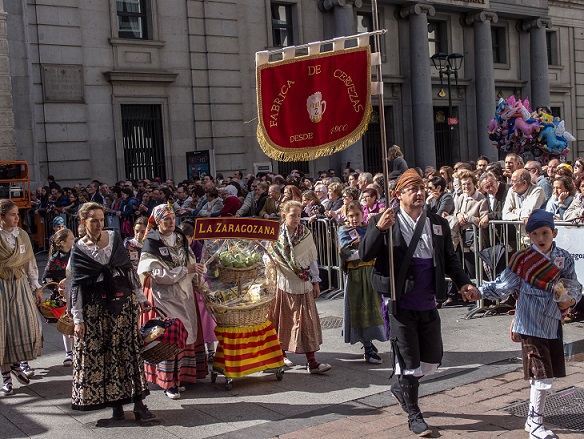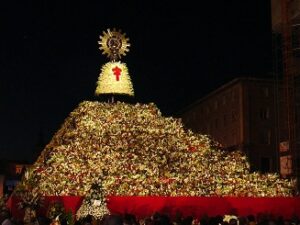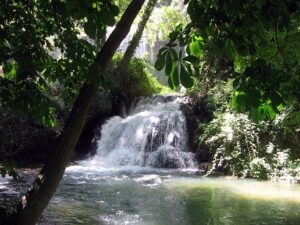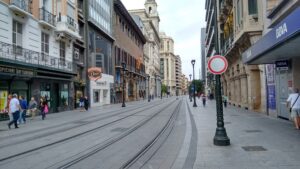Among its most celebrated features are its fiestas—festivals that highlight the region’s deep-rooted traditions, lively atmosphere, and unwavering sense of community. The fiestas of Zaragoza are an essential part of the city’s identity and offer visitors a chance to experience the region’s most cherished customs. Whether you’re a local or a tourist, the fiestas are a time for revelry, spiritual reflection, and a deep connection to the city’s history.
The Fiestas del Pilar: A Sacred and Spectacular Celebration

Arguably the most famous of Zaragoza’s festivals is the Fiestas del Pilar, celebrated in honour of the city’s patroness, Our Lady of the Pillar (Nuestra Señora del Pilar). Held every year in October, these festivities are a blend of religious devotion and vibrant cultural expression, attracting thousands of visitors from all over Spain and beyond.
The central event takes place on October 12th, the feast day of Our Lady of the Pillar, but the celebrations typically last for several days. The city’s grand basilica, the Basilica del Pilar, stands as the focal point of these festivities. Pilgrims and locals alike gather to honour the Virgin, participating in mass and traditional processions. However, the spirit of the festival extends far beyond religious observance.
During this period, Zaragoza bursts into a spectacular kaleidoscope of music, dancing, and parades. One of the most distinctive features of the fiestas is the “ofrenda de flores” (flower offering), where thousands of people, including entire families and groups, process through the streets carrying flowers to present to the Virgin. The sight of these vibrant floral displays, combined with the buzz of excitement in the air, is truly one of a kind.
 In addition to the religious events, the Fiestas del Pilar are marked by a wide range of secular activities. Traditional folk dances like the Jota Aragonesa, a regional dance that is part of the cultural heritage of Aragon, fill the streets. Music, fireworks, street performances, and even bullfights in the Plaza de Toros keep the energy high throughout the festival.
In addition to the religious events, the Fiestas del Pilar are marked by a wide range of secular activities. Traditional folk dances like the Jota Aragonesa, a regional dance that is part of the cultural heritage of Aragon, fill the streets. Music, fireworks, street performances, and even bullfights in the Plaza de Toros keep the energy high throughout the festival.
For those seeking a more modern twist, Zaragoza’s Fiestas del Pilar also offer open-air concerts, theatre performances, and art exhibitions. The combination of the old and the new makes it a festival that appeals to all tastes and interests.
La Romería de la Virgen de Torreciudad: A Pilgrimage with a Scenic Touch
Another key fiesta in Zaragoza’s calendar is the Romería de la Virgen de Torreciudad, which occurs in May. This religious pilgrimage is dedicated to the Virgin of Torreciudad, a beloved image located in the small village of Torreciudad, around 50 kilometres from Zaragoza. Devotees make their way to the sanctuary on foot, by bicycle, or in vehicles, dressed in traditional attire, and carry offerings to the Virgin. The journey is often marked by prayers and music, offering a peaceful respite from the modern world.
Although this pilgrimage is more serene compared to the exuberance of the Fiestas del Pilar, it offers a profound connection to the land and people of Aragon. The route itself is stunning, passing through the rolling hills and picturesque landscapes of the region, adding to the pilgrimage’s spiritual significance.
The Fiestas de San Valero: A Festivity for the Locals
While the Fiestas del Pilar may steal the spotlight, Zaragoza also celebrates San Valero on January 29th, in honour of the city’s patron saint. The festival is marked by a delightful tradition of tasting the “roscón de San Valero”, a ring-shaped pastry that is a local speciality. The streets come alive with various events, such as folk music performances, processions, and the opportunity to enjoy a hearty taste of Aragonese cuisine. While it may not have the grand scale of the Pilar festivities, the Fiestas de San Valero remain an important occasion for Zaragoza’s residents, evoking a sense of community and local pride.
The Fiestas de la Cincomarzada: A Celebration of Freedom
For a more politically charged celebration, the Cincomarzada (5th of March) commemorates an important historic victory in Zaragoza’s history. In 1838, during the First Carlist War, Zaragoza successfully defended itself against Carlist forces. This victory is celebrated every year with a blend of history and festivity. The city is filled with music, parades, and reenactments of the historic battle. Additionally, the city’s residents take the opportunity to gather in the city’s parks and public spaces for communal picnics, making this a day of leisure as well as historical reflection.
A Year-Round Celebration
While the larger fiestas may dominate Zaragoza’s cultural calendar, the city boasts a wealth of smaller, year-round celebrations. Whether it’s local saints’ days, music festivals, or culinary events like the Feria de la Ternasco (a festival dedicated to lamb, a regional delicacy), there is always something to celebrate in Zaragoza. These smaller events allow visitors to enjoy the local flavours and traditions at a more intimate level.
Related articles

Public transport network in Zaragoza
The bus network in Zaragoza is extensive, covering a vast majority of the city’s districts, as well as connecting to

Experience the gastronomy of Zaragoza
The food and drink of this historic city reflect both traditional Spanish flavours and unique regional influences, making Zaragoza an

Day trips within easy reach of Zaragoza
The region surrounding Zaragoza offers a treasure trove of fascinating destinations, all within an hour’s reach. Whether you’re traveling by

Lesser known things to do in Zaragoza
Once you have explored the main sights of Zaragoza, why not really get behind the scenes and find out more
